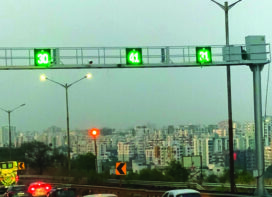Since the launch of National Highways Development Project (NHDP) by the government in 2000, toll collection has been gaining momentum on the national highways (NH) of India. While toll is already being collected on a distance of 9000km on the national highways, more area is being added to the figure at regular intervals.
At present, toll (or user fee) on national highways is being levied and collected in accordance with the provisions of the National Highways Act, 1956 and rules made there under. The salient features are:
(i) A ceiling has been prescribed for fee per kilometer for different types of vehicles by taking into account the saving in vehicle operating costs, damage caused by different type of vehicles, acceptability and willingness of users to pay.
(ii) The rates are revised periodically based on Wholesale Price Index (WPI).
(iii) An open system of tolling is being followed according to which the user has to pay for the notified length and not the actual length travelled.
(iv) Toll revenue goes to the Central Government in case of public funded projects and the concessionaire retains the fee in case of BOT (Toll) projects.
(v) In most of the countries, an alternative road (generally toll free) is available and therefore, the road user has the option of not using the road on which toll is levied. In India that option is generally not available.
(vi) In India, user fee is generally not charged for two wheelers, three wheelers and tractors.
At present, approximately 150 toll plazas are operating on the national highways. The toll operations are mainly manual – the receipt and collection of money are done manually while the receipts issued are computerised.
The traffic volume on the fast-growing national highway network in the coming years necessitates the introduction of Electronic Toll Collection (ETC) in India. Electronic payment, a popular mode of toll collection worldwide, processes the financial transactions without human intervention at the toll plaza.
When it was decided to introduce electronic toll collection in India, the major challenge was to finalise a single inter-operable ETC technology throughout the country. Following are some of the major ETC technologies being used in other parts of the world. Each technology, depending upon geographical locations and operational conditions, has its own merits and de-merits. The technologies are:
(i) Dedicated Short Range Communications (DSRC )
(ii) Radio Frequency Identification (RFID) in UHF band
(iii) Global Navigational satellite System/ Cellular Network (GNSS/CN) systems
(iv) Video Recording (Vehicle Identification System using number plates)
The distinct advantage with India in adopting ETC system is that there are no prior systems for reference unlike other developed countries. This helps to select a simple and robust ETC technology which is scalable, reliable and inexpensive to the road users and inter-operable across the country.
With this objective, the government constituted a committee under Nandan Nilekani, Chairman, Unique Identification Authority of India (UIDAI) with two outside experts nominated by him as members, besides the Director General (Road Development), Special Secretary, Ministry of Road Transport & Highways and Member (Technical), National Highways Authority of India as the other members of the committee. The scope of the committee was to examine all technologies available for electronic toll collection and recommend the most suitable one for implementation in India. The committee submitted its report in July 2010 recommending RFID based on EPC, Gen-2, ISO 18000-6C standards for electronic toll collection on national highways in India.
Implementation
Subsequent to the finalisation of ETC technology, the implementation of ETC systems would broadly involve the following activities:
(a) Preparation of ETC blueprint for India covering
(i) Standards / guidelines for India, technical specifications like frequency band, interoperability, protocols, data transfer, security, hardware / software life cycle, warranty etc.
(ii) ETC system architecture / methodology (LAN / WAN, backbone communication network, toll management software, middleware, ETC lane design, bank, points of sales (POS), distribution network, maintenance, after sales support / servicing, violation handling / enforcement
(iii) Central clearing house (CCH) – data communication between toll collecting agencies and CCH / bank, database table structure to be shared between operators, reconciliation of financial transactions, purchase / top-up of tags through credit cards, mobile banking, e-banking etc.
(iv) Administration (user registration, account no., coding of tag ID, information to be collected at the time of registration, registration fee, post-paid / pre-paid, violation handling/ enforcement)
(v) Information (sharing account details of users through web / mobile / email, guidelines for sharing information with other government agencies like police, other investigating agencies, tax authorities etc., generation of MIS reports by toll collecting agency / regulator / ministry
(vi) Dispute handling
(vii) Technology transfer / manufacturing in India
(b) Preparation of bid documents for procurement of ETC systems and setting up of central clearing house
(c) Installing / commissioning of ETC systems at toll plazas, central clearing house (CCH), setting up of points of sales (POS), networking toll plazas with central clearing house.
ETC Models
 Following are some of the alternative ETC models that can be considered for implementation in India:
Following are some of the alternative ETC models that can be considered for implementation in India:
(i) PPP Model: In this model, the capital and operational expenditure will be borne by the private entrepreneur. This model may attract participation of private entrepreneurs as the fund inflow by way of tag deposits (prepaid concept) would be substantial. The selected agency is expected to set up central clearing house, ETC systems at toll plazas enable networking of toll plazas with the CCH, tag distribution network, tie-up with banks, etc. and operate for a period of about 10 to 20 years.
(ii) Outsourcing Model: Considering the magnitude and complexity of interoperable ETC implementation in India, the entire project may be outsourced to an expert agency.
(iii) Special Purpose Vehicle (SPV) Model: MoRTH / NHAI may create a SPV for implementing and operating ETC systems in India.
(iv) MoRTH / NHAI may directly procure ETC systems at the toll plazas, set up central clearing house, networking of toll plazas, tag distribution network and tie-up with banks and operate.
System Architecture
It is essential to network all the toll plazas for seamless data communication between toll plazas and the central clearing house / data centre. For updating the toll data, two tier database structure may be deployed – one at the plaza level and the other at the national level (CCH / data centre). The entire transaction details of all the tag accounts may be stored in the central database.
System Operation
Before the issuance of RFID Tags, the road users need to register with the agency with the basic details like name, address, vehicle type, vehicle registration number, etc. This information will be stored in the central database along with the unique identification code of tag.
To begin with, one out of two lanes in each direction to be dedicated for ETC in each toll plaza. The number of ETC lanes may be increased depending on the traffic volume.
Each ETC lane may be equipped with automatic vehicle classification (AVC) system for cross verification of vehicle categories to avoid any misuse of tags. The ETC management software will compare the class of vehicle as per the tag account and the AVC class. In case of any discrepancy, the system triggers the camera fitted in the lane and captures the image of the vehicle along with the number plate. This information may be used for the enforcement of rules against vehicles violating the system.
Pre-screening of vehicles before entering ETC lane
With an objective to allow only vehicles with valid tags in ETC lanes, an automatic boom barrier in conjunction with the tag reader may be installed at the entry point of the ETC lane. In case a non-tag vehicle or a vehicle with invalid tag tries to enter the dedicated ETC lane, the tag reader detects the vehicle as non-tag vehicle and closes the barrier forcing it to divert to the adjacent cash lanes.
In case of valid tag vehicles, the tag reader detects the vehicle and opens the barrier allowing the vehicle to pass through the toll plaza without stopping.
 R C Palekar
General Manager(Electronics)
National Highways Authority of India
palekar.ravi@gmail.com
R C Palekar
General Manager(Electronics)
National Highways Authority of India
palekar.ravi@gmail.com
 TrafficInfraTech Magazine Linking People Places & Progress
TrafficInfraTech Magazine Linking People Places & Progress


